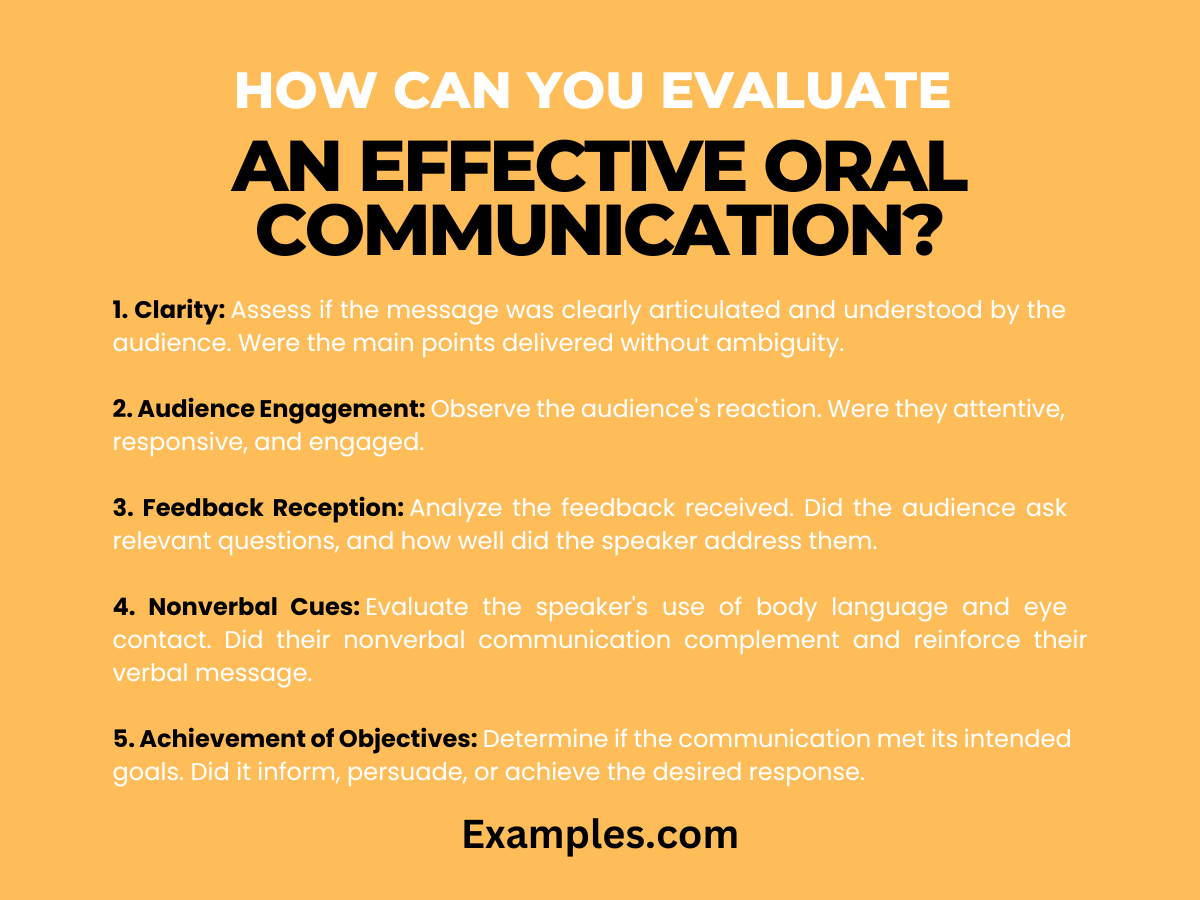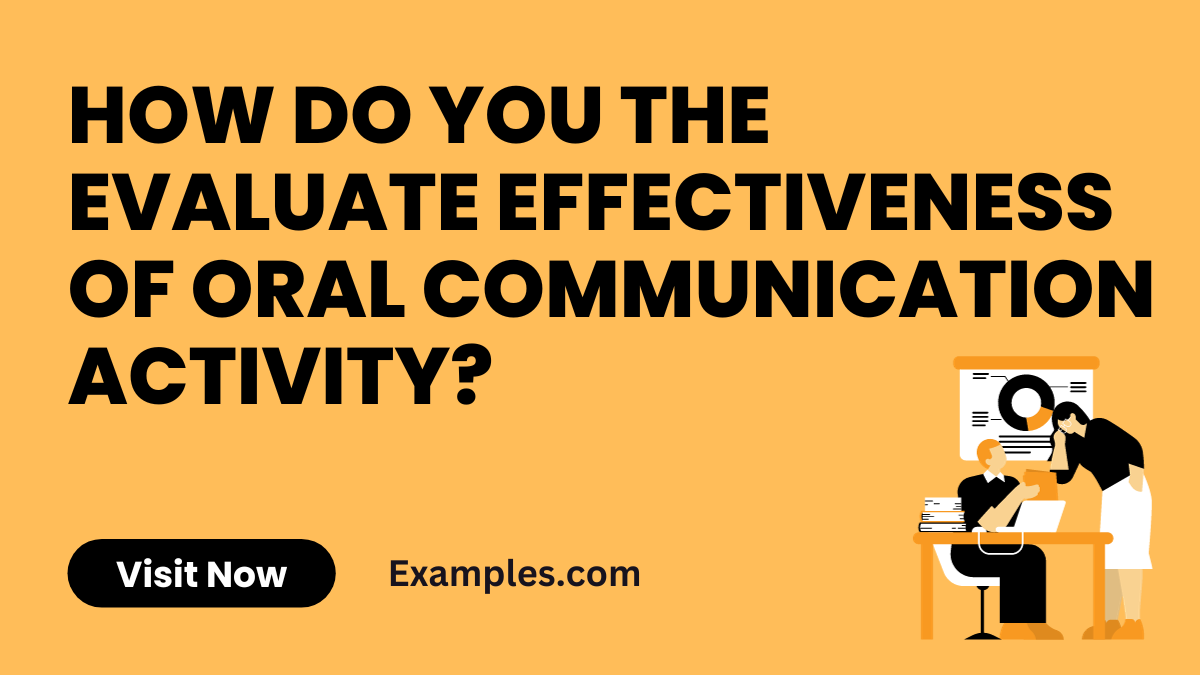How Do You Evaluate the Effectiveness of An Oral Communication Activity?
Evaluating the effectiveness of an oral communication activity is crucial for personal and professional development. This comprehensive guide provides insights into assessment techniques, supported by practical communication examples. Learn how to gauge the impact of your spoken words, understand audience reception, and refine your delivery style. We’ll explore various evaluation criteria, from clarity and audience engagement to feedback reception, ensuring you have the tools to assess and enhance your oral communication skills effectively. Join us as we unlock the secrets to successful communication evaluations.
How Can You Evaluate An Effective Oral Communication?

Evaluating effective oral communication involves a multi-faceted approach. This process assesses both the speaker’s delivery and the audience’s reception.
- Clarity: Assess if the message was clearly articulated and understood by the audience. Were the main points delivered without ambiguity?
- Audience Engagement: Observe the audience’s reaction. Were they attentive, responsive, and engaged?
- Feedback Reception: Analyze the feedback received. Did the audience ask relevant questions, and how well did the speaker address them?
- Nonverbal Cues: Evaluate the speaker’s use of body language and eye contact. Did their nonverbal communication complement and reinforce their verbal message?
- Achievement of Objectives: Determine if the communication met its intended goals. Did it inform, persuade, or achieve the desired response?
- Speaker’s Confidence and Preparedness: Consider the speaker’s confidence and mastery of the subject. Were they well-prepared and authoritative in their delivery?
By focusing on these aspects, you can effectively evaluate the effectiveness of an oral communication activity, ensuring it is impactful and achieves its intended purpose.
How Should You Assess Oral Communication Activities?
Evaluating oral communication activities effectively involves a multi-faceted approach. This assessment ensures the speaker’s message is clear, concise, and impactful. Here are key areas to consider:
Understanding
- Message Clarity: Determine if the message was clear and easily understood.
- Audience Understanding: Assess if the audience comprehended the message without confusion.
Presentation
- Articulation: Evaluate the speaker’s clarity of speech and pronunciation.
- Confidence and Poise: Observe the speaker’s confidence level and body language.
Engagement and Interaction
- Audience Engagement: Look at the audience’s response and interaction level.
- Feedback Reception: Consider how the speaker handles questions and feedback.
Content and Structure
- Relevance of Content: Check if the content is relevant and well-structured.
- Logical Flow: Assess the coherence and logical progression of ideas.
By focusing on these activities, one can effectively evaluate the strengths and areas for improvement in oral communication activities, leading to enhanced communication skills.
How Do You Demonstrate Effective Oral Communication?

Demonstrating effective oral communication involves several key aspects that ensure your message is not only delivered but also well-received and understood by the audience.
Precision
- Articulate Clearly: Speak distinctly, choosing words that convey your message without ambiguity.
- Be Precise: Use specific language to avoid misinterpretation.
Engaging Delivery
- Vocal Variety: Use tone, pitch, and volume variations to maintain audience interest.
- Pacing: Control the speed of your speech to match the content and audience understanding.
Body Language and Nonverbal Cues
- Expressive Gestures: Use appropriate body language to emphasize points.
- Maintain Eye Contact: Engage with the audience through consistent eye contact.
Listener Engagement
- Interactive Approach: Encourage audience participation and questions to create a two-way communication flow.
- Responsive Feedback: Show attentiveness to the audience’s reactions and adjust accordingly.
By focusing on these elements, you can ensure your oral communication is effective, engaging, and leaves a lasting impact on your audience.
How Can You Manage Oral Communication Activities Effectively in the Classroom?
Managing oral communication activities in the classroom involves strategic planning and execution to ensure they are effective and engaging for students.
Creating a Conducive Environment
- Comfortable Atmosphere: Establish a classroom environment that encourages open and respectful communication.
- Diverse Activities: Incorporate a variety of activities, like debates and presentations, to cater to different learning styles.
Encouraging Participation
- Inclusive Participation: Encourage all students to participate, ensuring everyone has a voice.
- Positive Reinforcement: Use positive feedback to motivate and build confidence in students.
Monitoring and Feedback
- Active Monitoring: Observe student interactions and provide real-time guidance.
- Constructive Feedback: Offer feedback that is specific, actionable, and supportive to help students improve.
Adapting to Student Needs
- Flexibility: Be prepared to adjust activities based on student responses and needs.
- Individual Attention: Recognize and accommodate individual communication challenges.
By implementing these strategies, educators can effectively manage oral communication activities, enhancing students’ speaking and listening skills in a supportive classroom setting.
How Can We Ensure the Effectiveness of Oral Communication?
Ensuring the effectiveness of oral communication involves several key strategies:
Clear Objectives
- Define Purpose: Establish a clear goal for the communication to guide your approach and content.
- Audience Analysis: Tailor your message based on the audience’s needs, interests, and level of understanding.
Effective Delivery
- Clarity and Conciseness: Use clear, concise language to convey your message.
- Nonverbal Cues: Employ appropriate body language, facial expressions, and gestures to reinforce your message.
Engaging Content
- Relevant Material: Ensure your content is pertinent and engaging to the audience.
- Storytelling: Incorporate anecdotes or examples to make the message more relatable and memorable.
Feedback Mechanisms
- Active Listening: Encourage and practice active listening to understand audience responses and adapt accordingly.
- Feedback Collection: Gather feedback to evaluate understanding and effectiveness, and to make necessary adjustments.
By following these strategies, you can significantly enhance the impact and effectiveness of your oral communication, ensuring your message is not only delivered but also well-received and understood.
How Can You Improve Oral Communication Activities?
Improving oral communication activities involves a multifaceted approach, focusing on both the speaker’s skills and the engagement of the audience.
Enhance Speaking Skills
- Practice and Preparation: Regularly practice speaking and prepare thoroughly for each communication opportunity.
- Seek Feedback: Actively seek constructive criticism from peers or mentors to identify areas for improvement.
Foster Audience Engagement
- Interactive Elements: Incorporate questions or interactive segments to engage the audience actively.
- Adapt to Audience Feedback: Be receptive to the audience’s reactions and adjust your communication style accordingly.
By focusing on these aspects, individuals can significantly enhance the effectiveness of their oral communication activities, leading to more impactful and engaging interactions.
In conclusion, evaluating the effectiveness of oral communication activities is an integral part of enhancing interpersonal and professional skills. It allows individuals and organizations to refine their communication strategies, ensuring messages are conveyed clearly and effectively. This process not only aids in personal development but also fosters a more productive and harmonious environment, whether in educational settings, workplaces, or social interactions.
To further explore the nuances of effective communication, interested readers can delve into resources provided by esteemed educational institutions. For instance, Harvard University’s resource on communication skills offers valuable insights and tips for professional settings. Additionally, The University of Kent’s guide provides a comprehensive overview of various aspects of communication, including oral communication, which is beneficial for both students and professionals looking to enhance their communication abilities. These resources, from high-authority domains, not only add depth to the understanding of oral communication effectiveness but also offer practical advice for continuous improvement.



